Variety of types and varieties of sea buckthorn
Sea buckthorn is useful and is used in cooking, medicine and cosmetology. Lush trees with orange berries also perform a decorative function - they decorate a summer cottage. Sea buckthorn is unpretentious in cultivation, requires little attention, and rarely gets sick. Small berries ripen in July–August and are stored for a long time. In this article we will look at the best varieties of sea buckthorn and talk about the advantages of each.
Types and varieties of sea buckthorn
Sea buckthorn can be early, mid-season and late. It is grown in all regions of Russia. The fruits are resistant to drought and frost. Most varieties are universal in use: vitamin jam, juice, jams, and compotes are prepared from the berries.
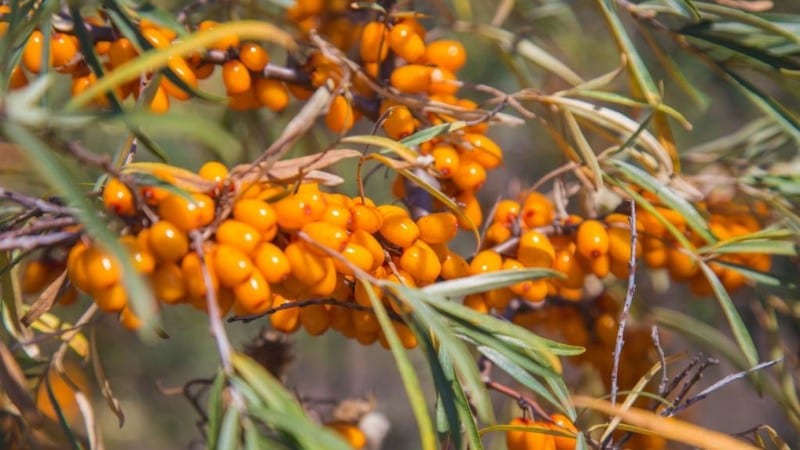
Most productive
The productivity of sea buckthorn depends on many factors: weather conditions, fertilizers and watering, choice of planting site, crown formation and cuttings of shoots.
Openwork
The Azhurny sea buckthorn variety is famous for its rich and stable harvest and is suitable for cultivation in the north of the country. The berries are orange, cylindrical in shape, weighing about 1 g. The taste is pleasant, tasting score - 4.9 points out of 5. They are universal in use, after ripening they do not crack or crumble. Productivity is about 10 kg per bush.
Girlfriend
The variety is mid-season - ripening lasts from August 26 to September 10. The plant is low-growing, the leaves are of a rich green hue, elongated. There are no thorns. The berries are oval, weight about 1 g, orange in color. The taste is pleasant, refreshing with a bright aroma. Fruit detachment is dry.Under favorable growing conditions, the yield of Podruga sea buckthorn reaches 8 kg per summer. The berries are used to make marshmallows, jelly, marmalade, and even puree.
Maslenitsa
Late summer variety with a yield of up to 25 kg per plant per season. The fruits are small, ovoid, weighing about 0.4 g. The color is brown-orange. Maslenitsa attracts gardeners with its appearance. The taste is sour and tart, not for everyone. The purpose is universal. The variety received its name due to the high juice content in the fruits.
The sweetest
Most varieties of sea buckthorn are sweet and sour, with a tart aftertaste. Summer residents appreciate fruits with a rich sea buckthorn aroma and pleasant, refreshing pulp.
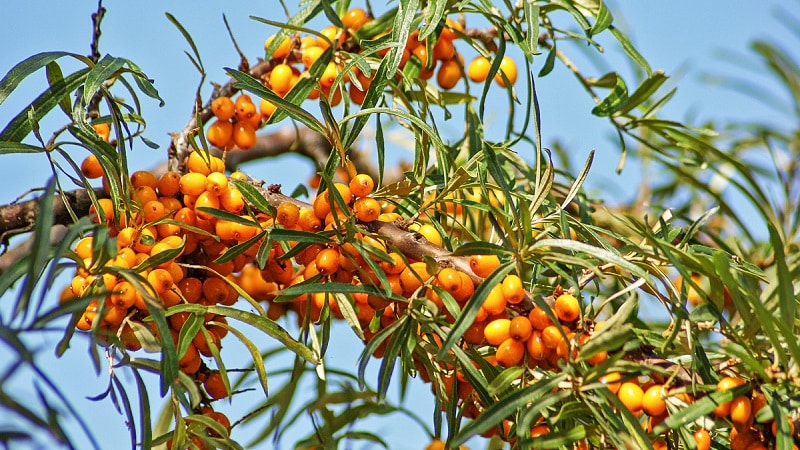
Inya
The bush is medium-sized, the crown is sparse, the thorniness is weak. The weight of the fruit is about 0.7 g, the shape is elongated, the color is red-orange. The pulp is dense, sweet and sour, the aroma is bright. The length of the stalk is about 4 mm, the tear is semi-dry. Inya ripens by early or mid-September. It is unpretentious in cultivation and rarely gets sick. Another advantage is early fruiting - Inya’s sea buckthorn bears fruit in the second year after landings.
Herringbone
Self-fertile and thornless sea buckthorn Herringbone is a godsend for any gardener. The plant is short, about 1.8 m high. The crown is pyramidal, light green. The fruits are small, the taste is sour and tart. They ripen at the end of September and look original. There are no thorns, which makes harvesting easier. The variety is resistant to mycotic wilt and does not sprout.
Interesting! Sea buckthorn oil is an effective folk remedy against gastric ulcers, gastritis, colitis, and laryngitis. The plant product is rich in phytosterols, palmitic acid and vitamin C. Sea buckthorn oil is a natural powerful antioxidant, anti-inflammatory and antibacterial agent.
Thornless
The advantage of such varieties is that during harvesting it is impossible to scratch your hands on thorns or introduce a splinter. Among the thornless ones, summer residents distinguish several crops. Let's look at the description of the sea buckthorn variety Elizaveta and Velikan.
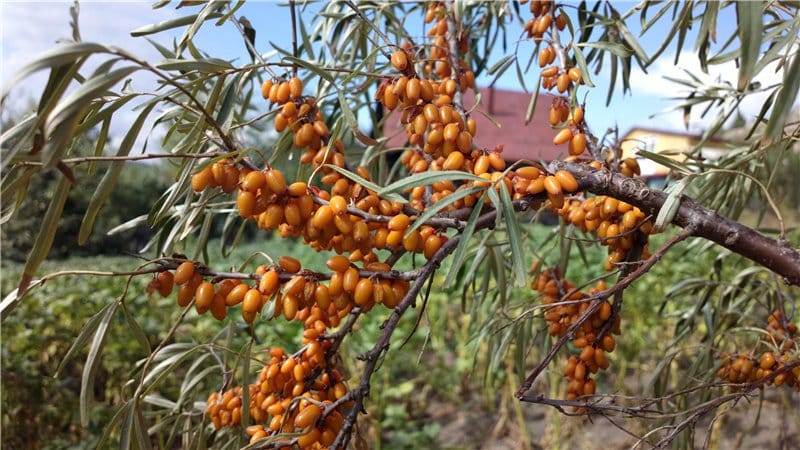
Elizabeth
Elizabeth is distinguished by medium-sized bushes with an oval crown up to 2 m high. Elizabeth blooms in May, the flowers are collected in compact inflorescences. The weight of the berry is about 1 g, the separation from the shoots is semi-dry. Sea buckthorn ripens in early September, and the tree bears fruit in the fourth year after planting. The color of the fruit is orange, the taste is sweet and sour with astringency. Elizaveta is frost-resistant and suitable for planting in any region of Russia.
Giant
Another thornless variety is Giant. The harvest ripens in mid-September. The weight of the fruit is about 1 g, the color is orange-golden, the shape is cylindrical-round. The pulp is dense and tender, the taste is sweet and sour, harmonious. Sea buckthorn Giant is suitable for processing and for fresh consumption.
Large-fruited
Large-fruited sea buckthorn is used for preservation and preparation of preparations for the winter, eaten fresh and dried in the sun. Gardeners recommend paying attention to Botanical sea buckthorn.
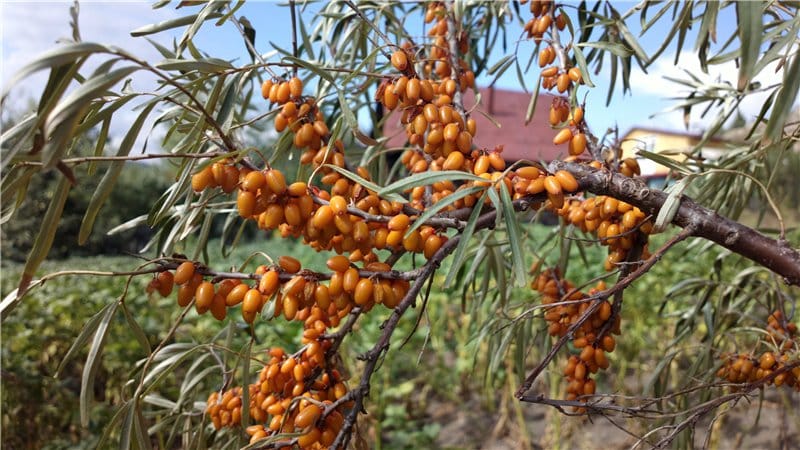
Botanical
The mid-early variety Botanicheskaya is characterized by large fruits. The weight of the berry is 0.7-1.2 g, the shape is rounded and elongated, the color is orange, with yellow tints. The skin is thin but durable, the peel is dry or semi-dry. The pulp is juicy, the taste is sour, pleasantly refreshing. A medium-sized bush with a pyramidal crown begins to bear fruit in the second year after planting. Botanical is grown in the Northwestern and Volga-Vyatka regions.
Amber
An attractive and original late-summer variety. The color is yellow-amber, the shape is round-oval.The taste is sweet and sour, the pulp is rich in vitamins A, C and E. The weight of the fruit is about 1 g, the peel is medium thick, oily. The harvest is about 10 kg per plant per season. The variety is frost-resistant and unpretentious. Summer residents also grow Yantarnaya for decorative purposes.
short
Low-growing bushy varieties are ideal for small areas; their height is no more than 3 m. They look neat and require little space.
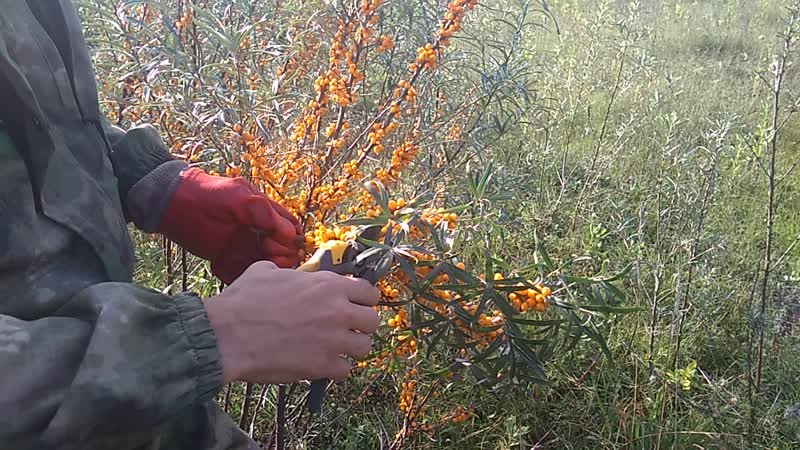
Friesdorfer Orange
The variety is partially self-fertile, the tree height is about 2.5 m, the crown is rounded. The fruits are large, deep orange in color, and the skin is dense. The seedlings are frost-resistant, but require abundant watering. The taste is sweet and sour, juicy, the aroma is bright. The fruits are used for processing and transported over long distances. Sunny areas are suitable for growing.
Excel
The bushes are medium-sized with an oval crown, there are few thorns. The weight of the berries is about 1 g, ovoid, dark orange. The pulp is sweet and sour, dessert. Excel ripens in the second decade of summer. The crop is grown for sale or processing - jams and jams are prepared.
Winter-hardy
Winter-hardy varieties can withstand temperatures down to -40°C and are not afraid of frost and wind. The best winter-hardy varieties of sea buckthorn are Excellent and Favorite.
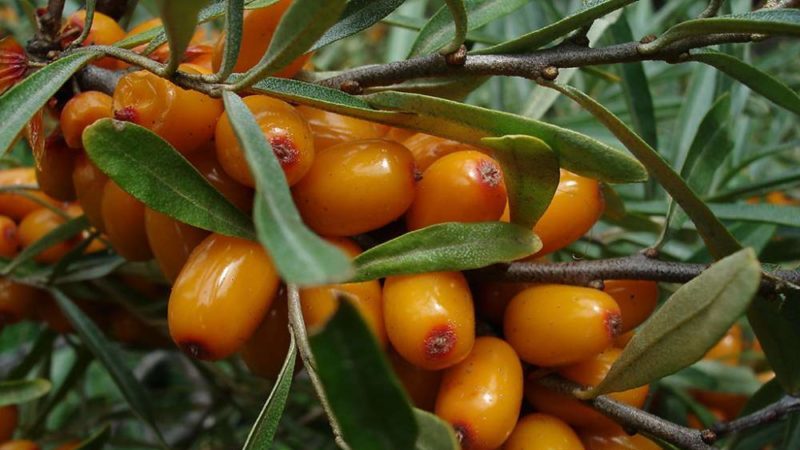
Excellent
The winter-hardy variety of sea buckthorn Excellent is grown in the Urals and Siberia. The late-summer ripening berry is universal in use. The bushes are medium-sized, round, height - up to 3 m. The shoots are green, there are no thorns. The fruits are oval, the taste is sweet and sour, weight - about 0.7 g. The color is bright orange, the peel is dense, glossy. Productivity - up to 10 kg per tree. Excellent used for all types of processing.
Darling
It is impossible not to say about the frost-resistant variety Favorite. The height of the tree is up to 2.5 m, the crown is spreading, bush-like.The leaves are light green, with pubescence. The weight of the berry is 0.6 g, the shape is oval-cylindrical, the color is rich orange. Tasting rating of Lyubimaya - 5 points out of 5. The variety is recommended for planting in the Central, Ural, and West Siberian regions.
Augustine
Augustine sea buckthorn is frost-resistant and ripens in July–August. The weight of the fruit is about 11 g, the shape is oval-round. The pulp is tender, the skin is thin. Productivity is about 5 kg per plant. The tearing is dry or semi-dry, the berries are universally used.
Male pollinating varieties
Male varieties are planted in areas where self-fertile sea buckthorn is grown. This proximity increases productivity. A popular pollinator variety is sea buckthorn Alei. The plant does not require special care, is frost-resistant, tall, the crown is thick and powerful. The shoots are without thorns, the taste of the fruit is pleasant, without bitterness. Vitamin tinctures and decoctions are prepared from sea buckthorn - they help during acute respiratory infections and strengthen the immune system.
The best varieties of sea buckthorn
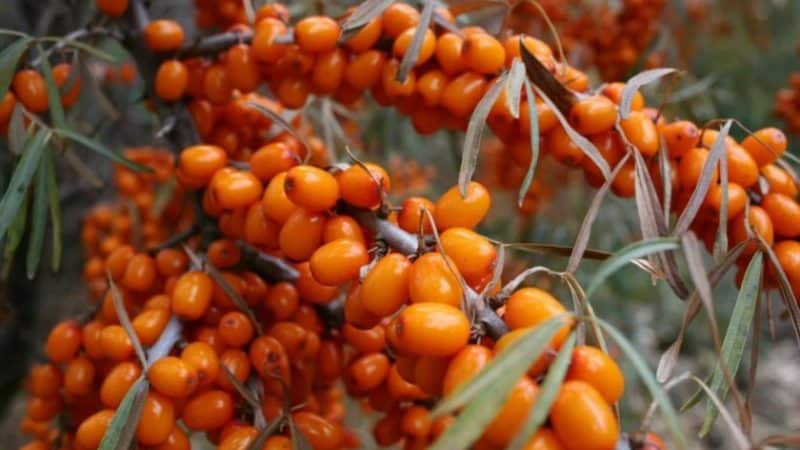
The growing region is an important criterion when choosing a variety. For the Urals, frost-resistant varieties are chosen, for the middle zone - unpretentious varieties with strong immunity.
For the Moscow region
The Moscow region is ideal for growing sea buckthorn. Warm summers increase productivity, the berries grow large and juicy. In the Moscow region, fruit trees are less likely to get sick.
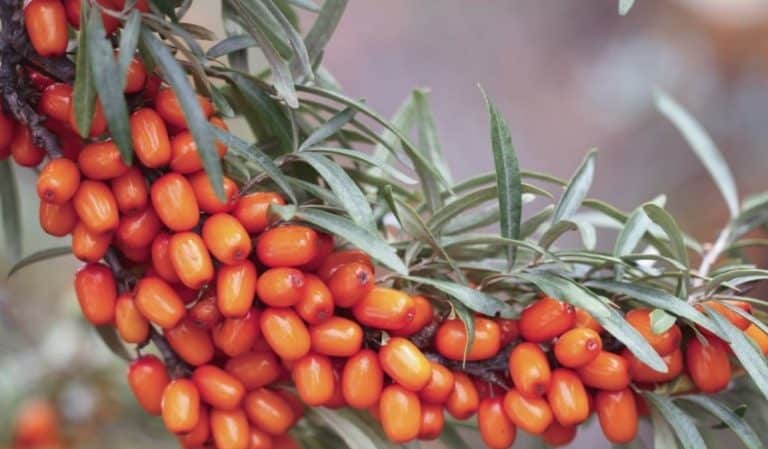
Roots
Sea buckthorn Ruet is universal in use and unpretentious in care. The bush is medium-sized, the crown is compressed. The shoots are erect, the thorns are short. The weight of the fruit is about 0.7 g, the shape is cylindrical. The pulp is delicate in consistency, with a sweet and sour taste and rich aroma. Ruet is an early ripening variety, yield is 1 kg per 1 sq. m.
Claudia
The fruits ripen in the second half of August.The shape of the berries is cylindrical, the color is rich orange, the weight is about 0.8 g. The taste is classic sea buckthorn, the aroma is pronounced. The variety is self-fertile and drought-resistant. The harvest is suitable for any type of processing; ripe berries retain their taste and commercial qualities for a long time.
For Siberia
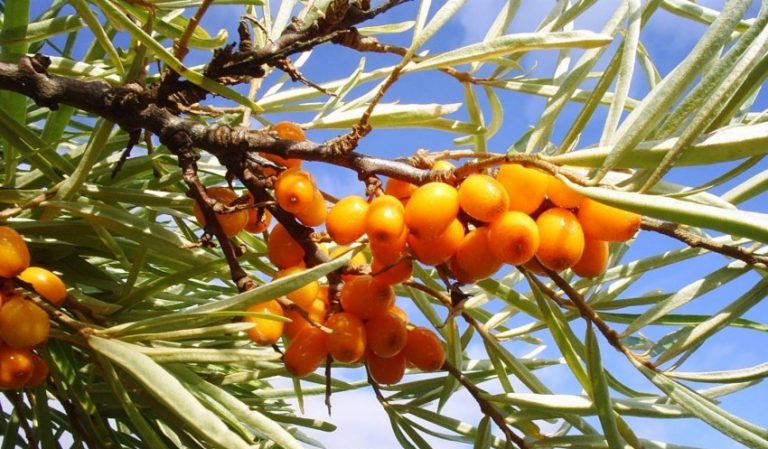
The Siberian winter is known for its frosts and gusty winds. To maintain productivity, plants are fertilized with phosphorus-potassium fertilizers, and during the flowering period they are sprayed with the Zdraven mineral complex.
Herringbone
Self-fertile and thornless sea buckthorn The Christmas tree is a godsend for any gardener. The plant is short, about 1.8 m high. The crown is pyramidal, light green. The fruits are small, the taste is sour and tart. They ripen at the end of September and look original. There are no thorns, which makes harvesting easier. The variety is resistant to mycotic wilt and does not sprout.
Pepper
The mid-season variety is grown in spacious and well-lit areas. The fruits are small, weighing about 0.5 g. The color is orange, the shape is ovoid, the peel is shiny. The taste is sweet and sour, the aroma is average. The purpose of the fruit is technical. Productivity is about 2 kg per 1 sq. m.
For the Urals
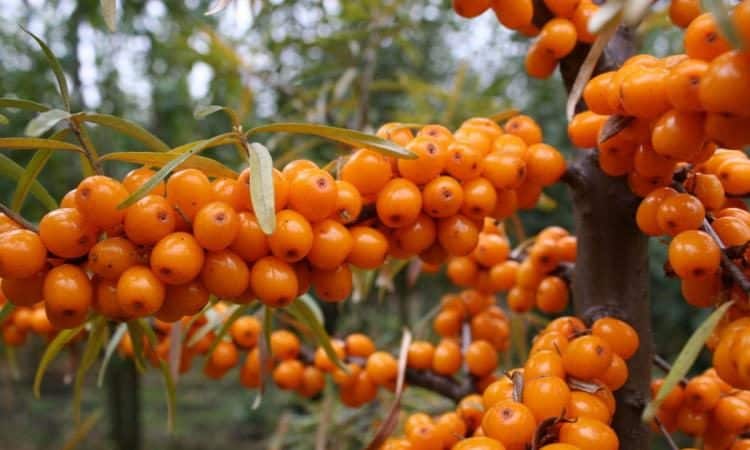
Ural summer residents plant Nivelen's sea buckthorn. The bushes are medium-sized, the crown is slightly spreading. The shoots are covered with thin spines. Fruit weight is 0.5-0.8 g, oval-round shape, yellow-orange color. The taste is sweet and sour with a rich and pleasant aroma. The ripening period is mid-early, the berries are universally used. Nivelena is frost-resistant and transportable, resistant to diseases and pests.
The Golden Cob variety is also grown in the Urals. The fruiting period begins 3-4 years after planting; the berries ripen in late August - early September. The fruits are oval, orange, weighing about 5 g.Productivity - up to 10 kg per bush. The Golden Cob has few thorns.
This is interesting:
Lime varieties - description and characteristics
Easy-to-care gooseberry variety “Yarovaya” - ideal for the most delicious preparations
Conclusion
Sea buckthorn lovers grow the Inya and Elochka varieties with large and juicy berries with an interesting sweet and sour taste. Gardeners who value stable and high yields grow openwork, Podruga or Maslenichnaya sea buckthorn. The berry decorates the area with its original color and bushy compact trees. The fruits are used fresh or made into jams, preserves, marmalade, and marshmallows. It is also important to pay attention to the ripening period of the variety and the recommended growing region.